Europeana provides various ways to work with and reuse their data. For example, it is possible to create your own galleries for learning or information dissemination purposes using Europeana’s resources. OpenUp! focuses on providing thematic galleries with natural history data that combine natural and cultural history artefacts.
Follow the images to view the Europeana Galleries!
Invasive Species
If species spread to areas outside their native range as a result of global changes or human activity, they are referred to as invasive species. They can cause considerable damage by displacing native species or causing economic and health-related consequential costs. The topic of invasive species is everlasting in a world of globalization and climate change and can be depicted by many examples. The fauna as well as the flora of the world provide a large variety of species that became invasive due to different reasons.
OpenUp! wants to put the spotlight on invasive species in the European area and therefore looks at a different species every month, combining it with Europeana materials. As a foundation for the following chapters, which will be extended every month, serves the union’s list for invasive species from 2016. The list started with 37 animal and plant species not native to Europe and expands continuously. It exclusively takes up species that represent a threat to a union-wide area.
- NABU contribution to invasive species
- Regulation of the prevention and management of the introduction and spread of invasive alien species
Index
- Mesquite Tree (Aug 2024)
- Grey Squirrel (Jul 2024)
- African Fountain Grass (Jun 2024)
- Asian Hornet (May 2024)
- Golden Wreath Wattle (Apr 2024)
- Raccoon Dog (Mar 2024)
- Giant Hogweed (Feb 2024)
- Common Myna (Jan 2024)
- Tree of Heaven (Dec 2023)
- Spiny-cheek Crayfish (Nov 2023)
- Water Lettuce (Oct 2023)
- The Red Fire Ant (Sep 2023)
Mesquite Tree (Aug 2024)
The tropical species Prosopis juliflora naturally grows in Mexico, Middle America and northern South America and was brought to Europe for horticultural and silvicultural trading reasons. In Europe the habitat of the tree is still restricted to Spain and the island Gran Canaria, where the species is established by now.
Its further dissemination is bound by the frequency of very low temperatures. Through a generally warmer climate it could spread to northern regions.
Concerning European biodiversity the Mesquite tree could potentially displace local species and additionally has an impact on the soil’s water ressources and nutrient cycles. The spreading of the plant can also lead to a decrease of quality pasture land. The actual impacts have not been studied yet.
Prosopis juliflora by Real Jardín Botánico Madrid licensed under CC BY-NC-SA
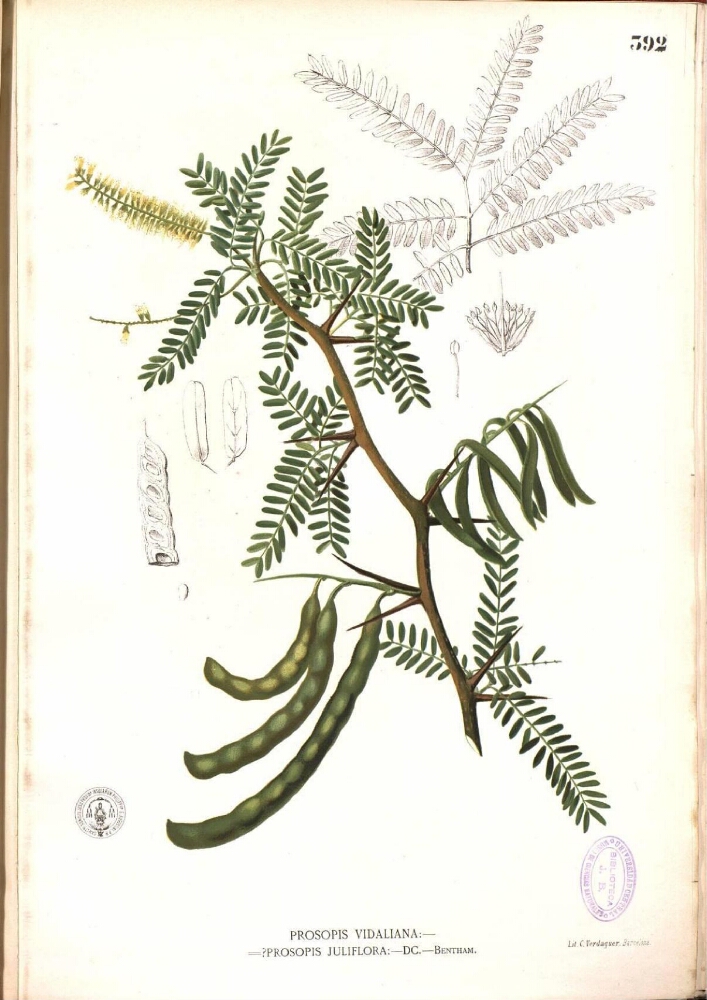
Additional Material
- Information on measures and related costs in relation to species considered for inclusion on the Union list: Prosopis juliflora (en)
- Changes in the Invasion Rate of Prosopis juliflora and Its Impact on Depletion of Groundwater in the Northern Part of the United Arab Emirates (en)
- An invasive, thorny tree is taking over Africa—can it be stopped? (en)
Grey Squirrel (Jul 2024)
The Grey Squirrel (Sciurus carolinensis) was introduced to Europe in the 18th century due to trading reasons. Through escaped individuals and intentional release the species got established in Europe’s ecosystem. Its original habitat is Eastern North America.
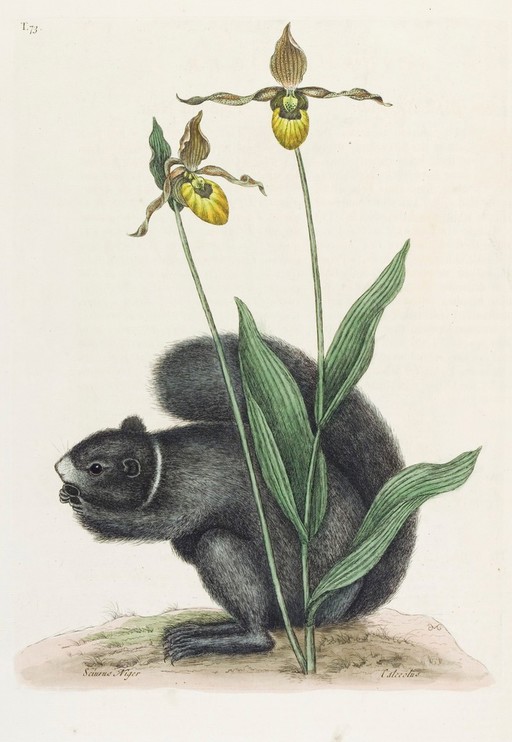
The squirrel species is directly competing with the local European squirrel and has managed to replace it to a certain degree. The Gray Squirrel may transmit a smallpox virus not known by the local species. They are also known to sometimes transmit pathogens to humans.Another disadvantage of the Grey Squirrel building its habitat in Europe are the damages on the barks of trees and resulting fungus infections.
Lady’s slipper orchid from The natural history of Carolina… by Wellcome Collection licensed under CC BY
Additional Material
- Introduction of the American grey squirrel (Sciurus carolinensis) in Europe: A case study in biological invasion (en)
- An Invasive Mammal (the Gray Squirrel, Sciurus carolinensis) Commonly Hosts Diverse and Atypical Genotypes of the Zoonotic Pathogen Borrelia burgdorferi Sensu Lato (en)
- Invasive Arten – Kampf ums Eichhörnchen (de)
African Fountain Grass (Jun 2024)
The african fountain grass (Pennisetum setaceum) originates in the north of Africa with an area reaching from Marocco to the Arab peninsula. It was brought to Europe as a decoration plant and was disseminated in South Europe through unintentional loss of seeds.
The dissemination of the species is still limited to Southern Europe and countries like Spain, France and Italy. Through the gradual rising of the temperatures due to climate change it could spread to the northern regions. The rapid growth of the fountain grass leads to other local plants being replaced. A big population has an impact on the soil’s nutriant circulation which has negative effects on the composition of plant species. In addition, it could give a rise to the frequency and duration of natural and unnatural fires.
Pennisetum setaceum (Forssk.) Chiov. by Università degli studi di Trieste licensed under CC BY-SA
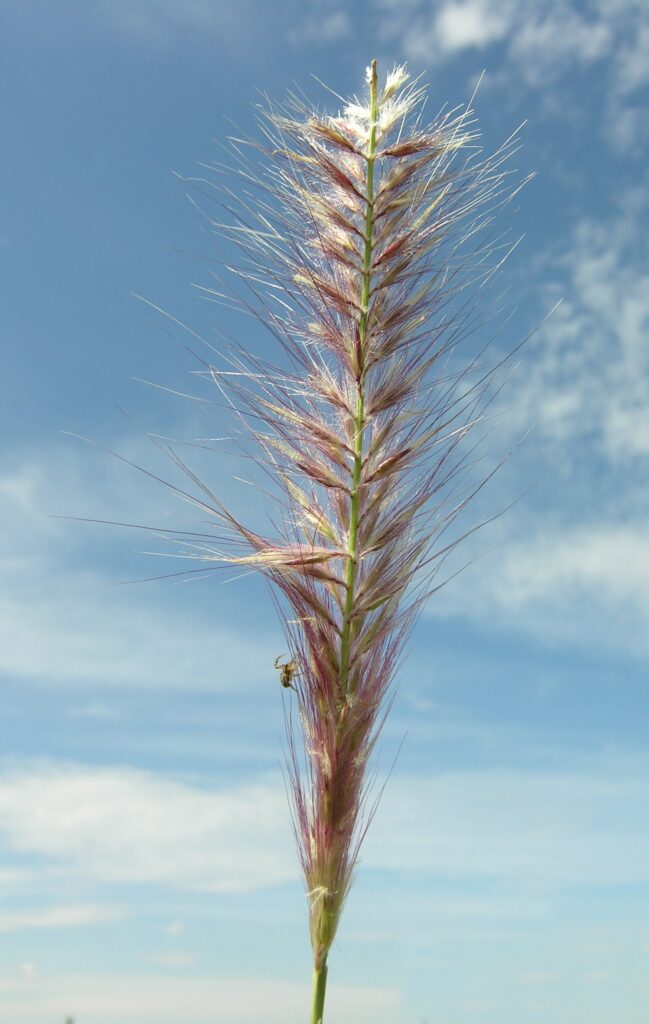
Additional Material
- Information on measures and related costs in relation to species included on the Union list (en)
- Cabi Digital Library (en)
- Graminoid Invasion in an Insular Endemism Hotspot and Its Protected Areas (en)
Asian Hornet (May 2024)
The Asian or Yellow-legged Hornet is native to Central and Eastern Asia and was probably imported to France in the first place by accident. The dissemination in Europe happened mostly through natural ways. The species is a little smaller than the European Hornet and builds its nests in higher trees in the woods but doesn’t neglect urban sites either.
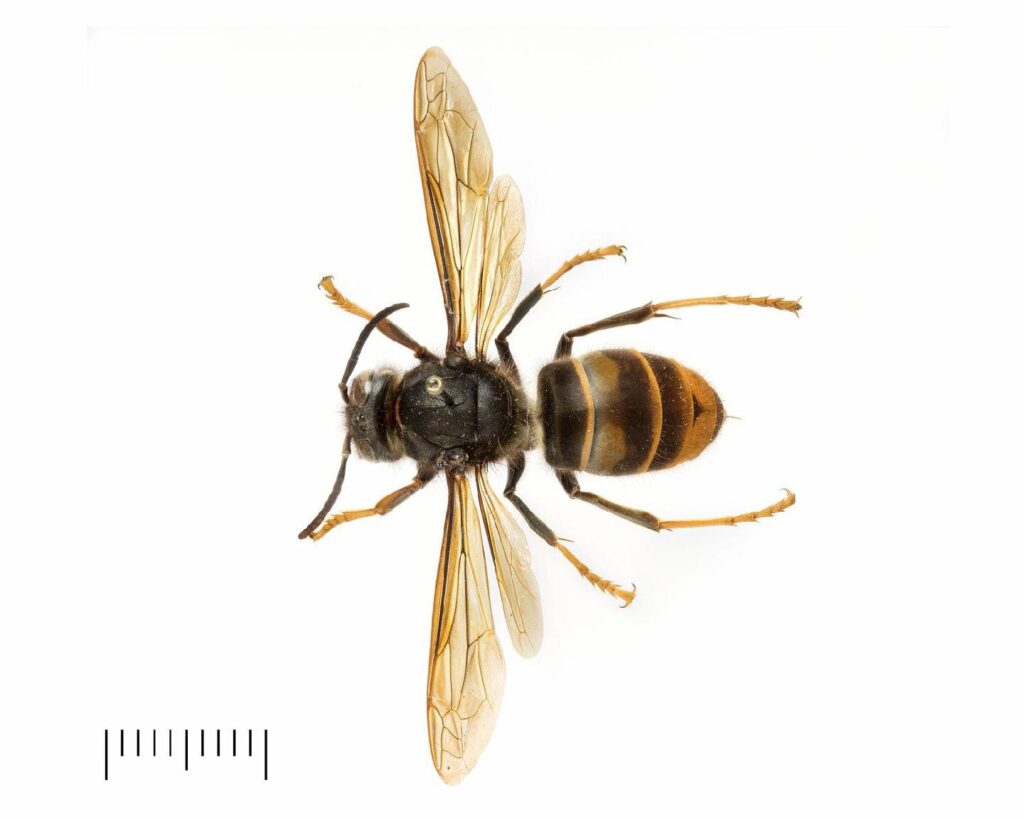
The predatory species feeds on several insects like the honey bee and therefore poses a great threat to the European bee populations. Up to 85 % of the hornets prey can be bees. With a declining bee population the pollination performance will equally decline and there could be apicultural problems leading to a price increase in bee products and a questionable general availability of them. The further dissemination of the hornet will also have an impact on fruit and wine cultures in middle and southern Europe.
The rising temperatures in the cold months of the year will support the population growth whereas a dry summer can limit their spreading.
Vespa velutina Lepeletier, 1836 by The Trustees of the Natural History Museum, London licensed under CC BY
Additional Material
- AGES – Health for humans, animals & plants – Asian Hornet (en, de)
- Searching for nests of the invasive Asian hornet (Vespa velutina) using radio-telemetry (en)
- Molecular Identification of Asian Hornet Vespa velutina nigrithorax Prey from Larval Gut Contents: A Promising Method to Study the Diet of an Invasive Pest (en)
- BeeBase – Asian Hornet (en)
Golden wreath wattle (Apr 2024)
The golden wreath wattle (Acacia saligna) originally comes from South-West Australia and was imported to Southern Europe for stabilising sand dunes and for silvicultural reasons. It was also used as a decorating plant and for biomass production. The dissemination of the plant is still restricted to southern European countries like France, Greece and Italy. Climate models are suggesting an expansion of the distribution area as the temperatures in Europe are gradually rising.
The plant forms a dense population in its growing area which favores the reduction of local plant populations. This can also affect species currently residing on the Red List of the EU.
In addition, acacia saligna is a host to the fire bacteria which may infest olive trees. The pollen of the species can lead to allergic reactions.
Acacia saligna (Labill.) H.L.Wendl. by Department of Life Sciences, University of Trieste, Italy is licensed under CC BY-SA
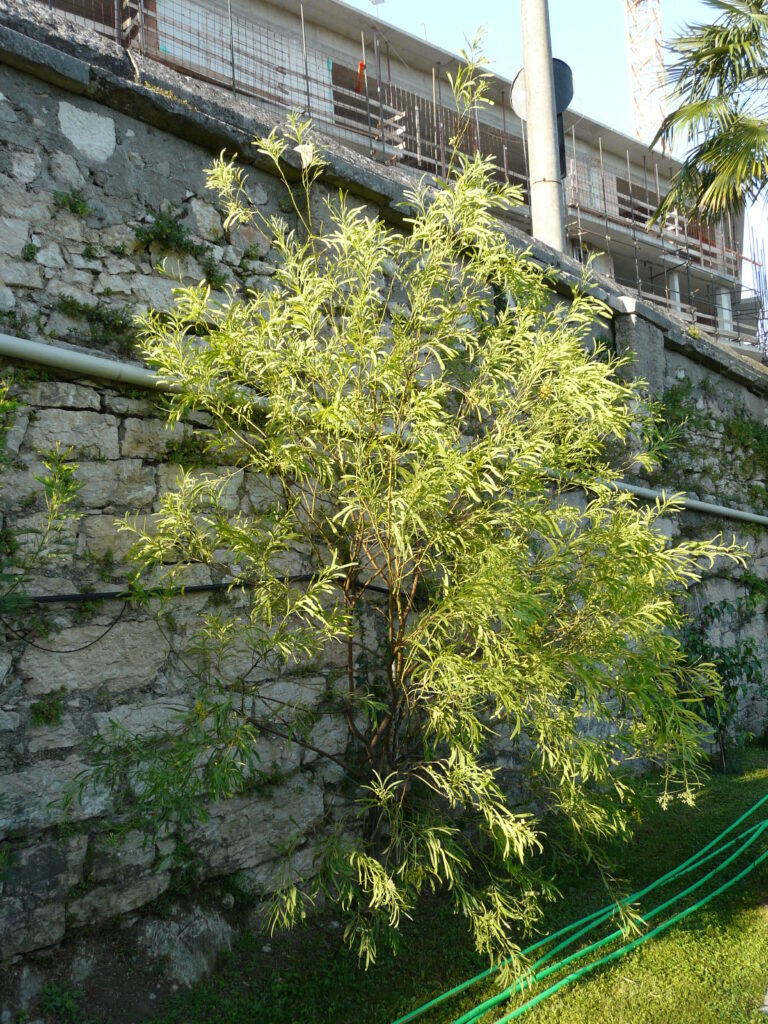
Additional Material
- High rock content enhances plant resistance to drought in saline topsoils
- Acacia saligna (Labill.) H. Wendl in the Sesimbra County: Invaded habitats and potential distribution modeling
Raccoon Dog (Mar 2024)
Nyctereutes procyonoides Gray, 1834, also called raccoon dog originally comes from Asian and Russian regions and found its way to Europe through Eastern European fur production sites. Trading of the animal for fur production is still common. Fleeing from captivity it managed to establish itself in many European countries. The dissemination of the raccon dog is connected to climate conditions, meaning that a warmer climate would pave its way to more northern territories.

The raccoon dog has a negative impact on regional species, especially those being direct prey of the small predator, like amphibians, mollusks, rodents, insects and reptiles. In addition, it can be a carrier of pathogens like rabies or parasites like Echinococcus multilocularis.
There are also documented agricultural damages concerning the cultivation of corn, strawberries, blackberries and blueberries.
Träsnitt, Albumblad, Böcker by Katsushika Hokusai – Museum of Far Eastern Antiquities, Sweden is licensed under CC BY.
Additional Material
- Raccoons and raccoon dogs are expected to expand their ranges in Europe (en)
- ZOWIAC project Raccon Dog (en)
- EU Management of the invasive Raccoon Dog (Nyctereutes procyonoides) in the north-European countries (en)
Giant Hogweed (Feb 2024)
Heracleum mantegazzianum, also known as Giant Hogweed, originated in the western Caucasian region and was intentionally imported to Europe in the 19th century as a decorative plant. By now the plant is well established all over Europe, while the dissemination happens through rubble and garden waste, among others.
The Giant Hogweed preferes higher altitudes and rainfall. Climate change could impact a shifting of the species to colder and less dry regions. In its current habitats it has negavtive impacts on the structures of plant and animal species, for which they might be poisonous.
In addition, its location beneath water bodies leads to higher erosion hazards at shores and therefore causes high management costs.
Heracleum mantegazzianum Sommier & Levier by Università degli studi di Trieste is licensed under CC BY-SA
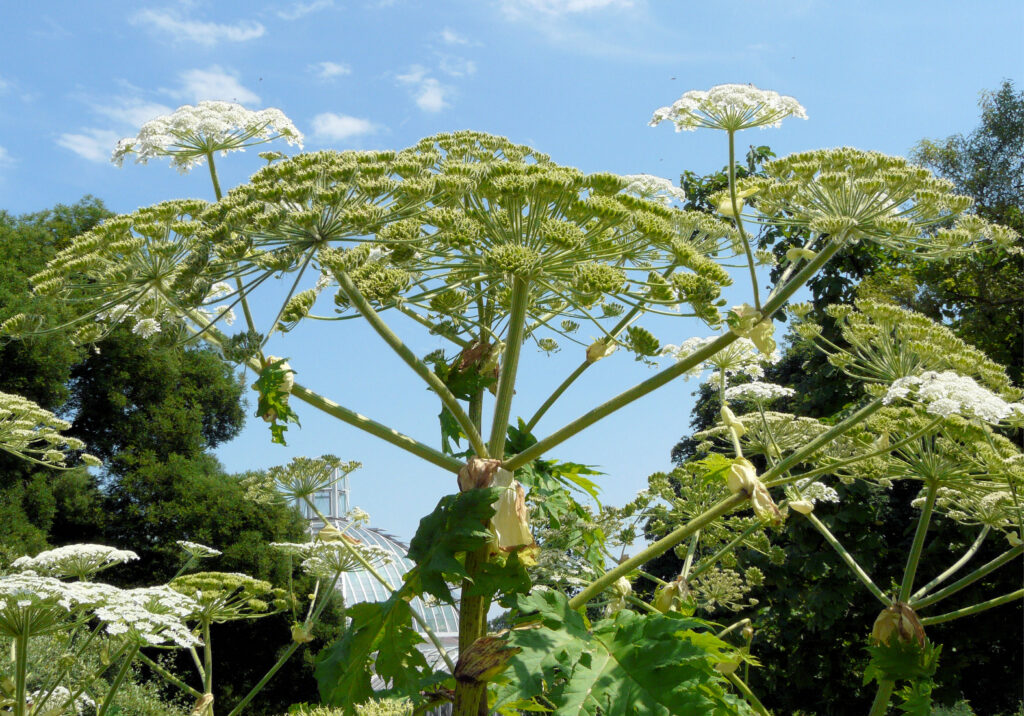
Additional Material
- Predicted range shifts of invasive giant hogweed (Heracleum mantegazzianum) in Europe (en)
- High abundance but low diversity of floral visitors on invasive Heracleum mantegazzianum (Apiaceae) (en)
- Riesen-Bärenklau: Informationen und Management (de)
Common Myna (Jan 2024)
The Common Myna originally comes from Central to Southeast Asia and was brought to Europe partly for zoological purposes and partly by accident. There are at least 8 EU member states reporting the existence of the bird in their country. It is accustomed to a fairly warm climate and its growth could be limited due to the harsh winters in Europe. It is possible that through climate change and rising temperatures, the growth of the population in Europe willl be enhanced.
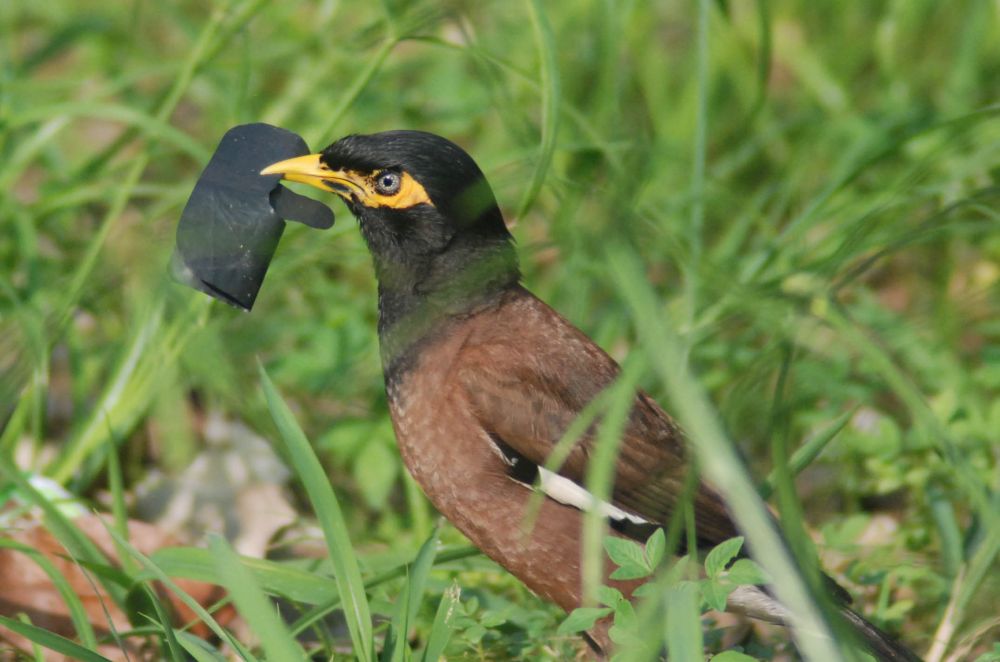
They are known to destroy other bird’s nests and kill the young ones. The species can transmit different pathogens but it is still unknown if they pose a threat to local species (Austria).
Another ecological side effect availability of food for the birds. In areas with little amounts of insects, they shift to fruit and seeds, which can reduce agricultural outcomes. Their sleeping areas could become a place with high noice levels and pollution.
Acridotheres tristis Linnaeus, 1766 by Berlin-Dahlem Botanical Garden and Botanical Museum is licensed under CC BY-SA.
Additional Material
- Accelerated avian invasion into the Mediterranean region endangers biodiversity and mandates international collaboration (en)
- Past and present distribution of the Common Myna Acridotheres tristis in Italy: a review (en)
- Datasheet CABI Digital Library (en)
Tree of Heaven (Dec 2023)
Ailanthus altissima was imported to England from Eastern Asia in the 16th century and was brought to the mainland from there. It is now well established in Europe and prefers a warmer climate. It threatens local biodiversity and causes infrastructural damages. Its components may evoke allergic reactions, breathing problems and rashes.
Through climate change, the amount of areas where Tree of Heaven can grow rises gradually. Until now, most of the trees were situated in cities, but the expansion to the countryside has already started. The tree does not pose a grave threat to the local environment, but it is indeed very hard to get rid of them once they are established. Preventional measures are recommended.
Ailanthus altissima (Mill.) Swingle by Università degli studi di Trieste is licensed under CC BY-SA
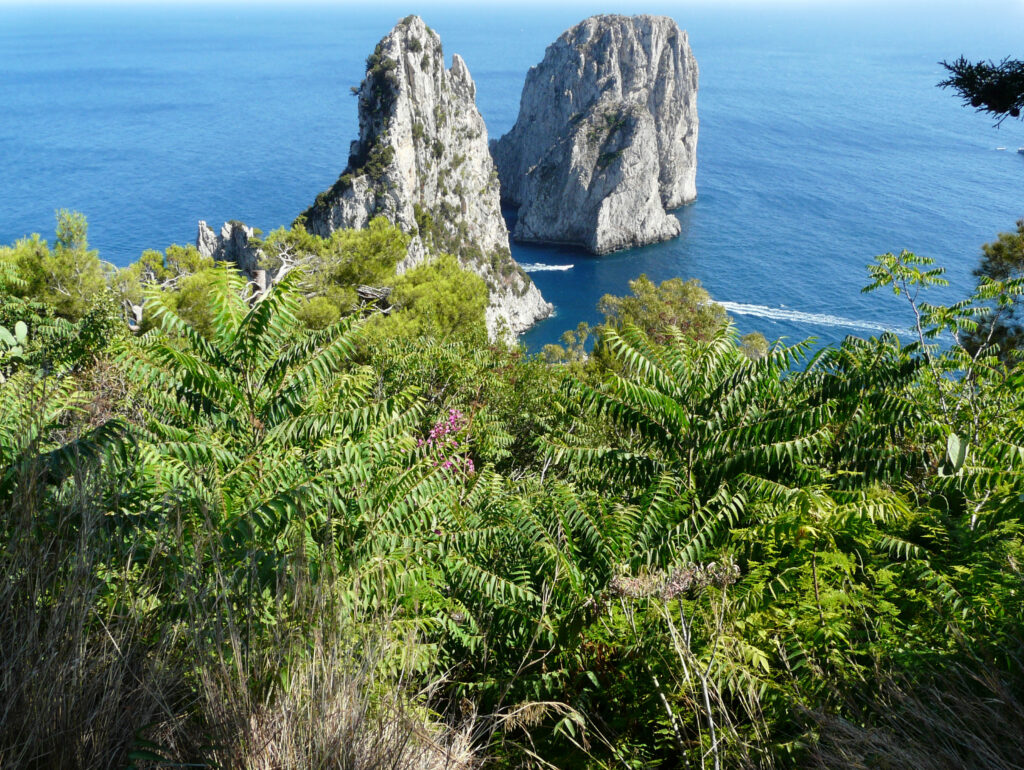
Additional Material
- Between approval and disapproval: Citizens’ views on the invasive tree Ailanthus altissima and its management (en)
- Invasive alien plant species in unmanaged forest reserves, Austria (en)
- Utilization Potential of Tree-of-Heaven Species Biomass—A Review (en)
- Review on Invasive Tree of Heaven (Ailanthus altissima (Mill.) Swingle) Conflicting Values: Assessment of Its Ecosystem Services and Potential Biological Threat (en)
Spiny-cheek crayfish (Nov 2023)
The spiny-cheek crayfish (Orconectes limosus) originated in the east of North America and was brought to Europe at the end of the 19th century. The up to 12 cm long crayfish is widespread in various countries of middle Europe. They transmit a specific plague that threatens local crayfish species that don’t have any defense mechanisms against it. The reproduction of the species has a direct impact on plant and animal populations.
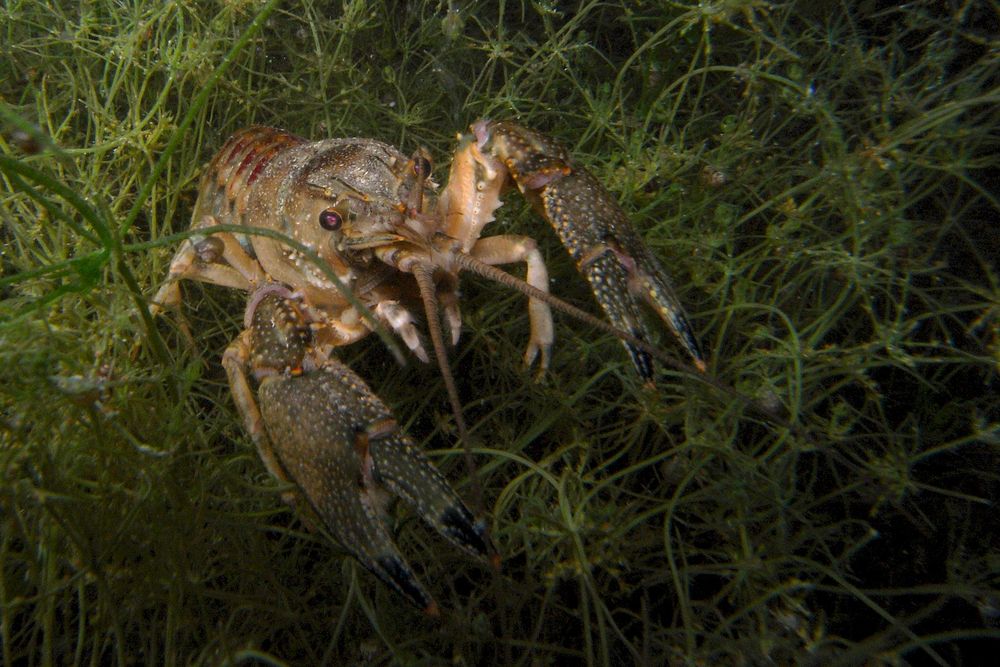
The current dissemination of the crayfish is favored by the transposition through humans. While the amount of crayfish in Europe is rising and local species are disappearing, the Orconectes limosus is fighting against extinction in its origínal habitat. By digging the material at the river banks, the species could enhance erosion and destabilize them.
Orconectes limosus (Rafinesque, 1817) by Botanischer Garten und Botanisches Museum Berlin is licensed under CC BY-SA
Additional Material
- Aquatische Neobiota in Österreich (de)
- Invasive Crayfish on Land: Orconectes limosus (Rafinesque, 1817) (Decapoda: Cambaridae) Crossed a Terrestrial Barrier to Move from a Side Arm into the Danube River at Szeremle, Hungary (en)
- An updated classification of the freshwater crayfishes (Decapoda: Astacidea) of the world, with a complete species list (en)
Water lettuce (Oct 2023)
Pistia stratiotes (water lettuce) is a water plant native to tropical and subtropical fresh water zones. The plant is very popular for ornamentic and aquarisitic purposes. The survival of the species in open terrain is favored by the rising temperatures which drive its dissemination. It adapts easily to changing conditions and shows a high reproduction rate. It will be added to the union’s list of invasive arts in Europe in August 2024 after a transition phase.
With rising temperatures the dissemination of the species is favored. Water lettuce forms a dense network and, if it develops en masse, can reduce solar radiation and thus light availability. This leads to hydrochemical and structural changes in the water body (e.g. oxygen and nitrite content) and affects water quality, which in turn has negative effects on other plants and animal species.
In addition, it has negative effects on a variety of uses of water bodies. Monodominant stocks affect navigation and fisheries, as well as agriculture (in rice crops), water management (blockage of irrigation canals), and recreational use of water bodies.
Pistia stratiotes by Real Jardín Botánico Madrid is licensed under CC BY-NC-SA
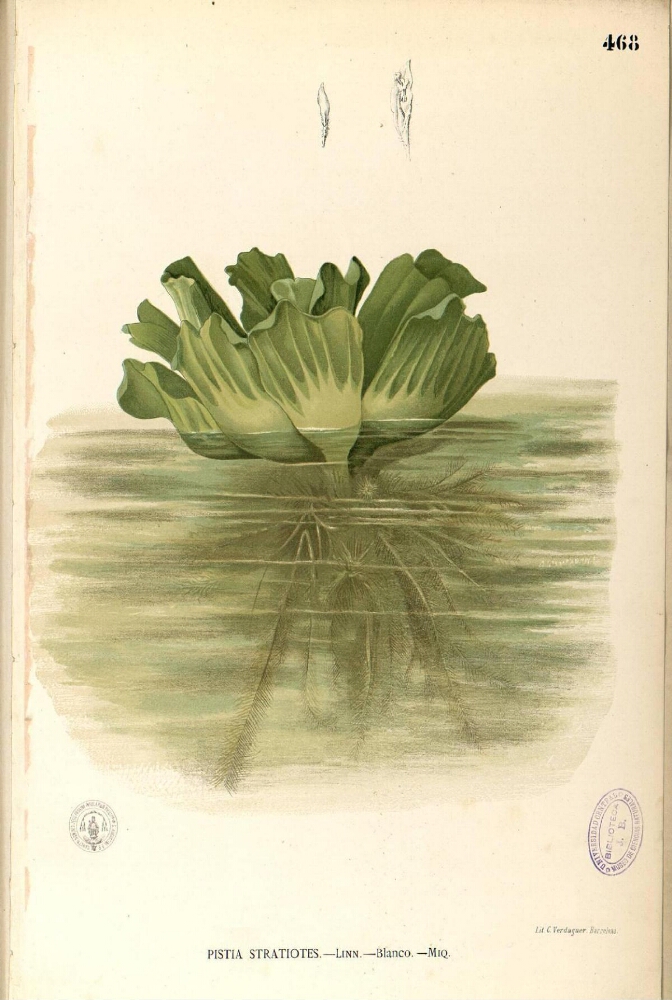
Additional Material
- Wikipedia – Pistia Stratiotes
- The beginnings of Pistia stratiotes L. invasion in the lower Danube delta: the first record for the Province of Vojvodina (Serbia) (en)
- Short Description (de)
The Red Fire Ant (Sep 2023)
The fire ant originates in South America and is spreading – supported by climate change – over several contintents. Its habitats expanded due to the rising temperatures and general globalization to Mexico, USA, China, Taiwan, Australia and recently to Sicily. By reaching Europe the ant species is posing a grave threat to the local agriculture and biodiversity.
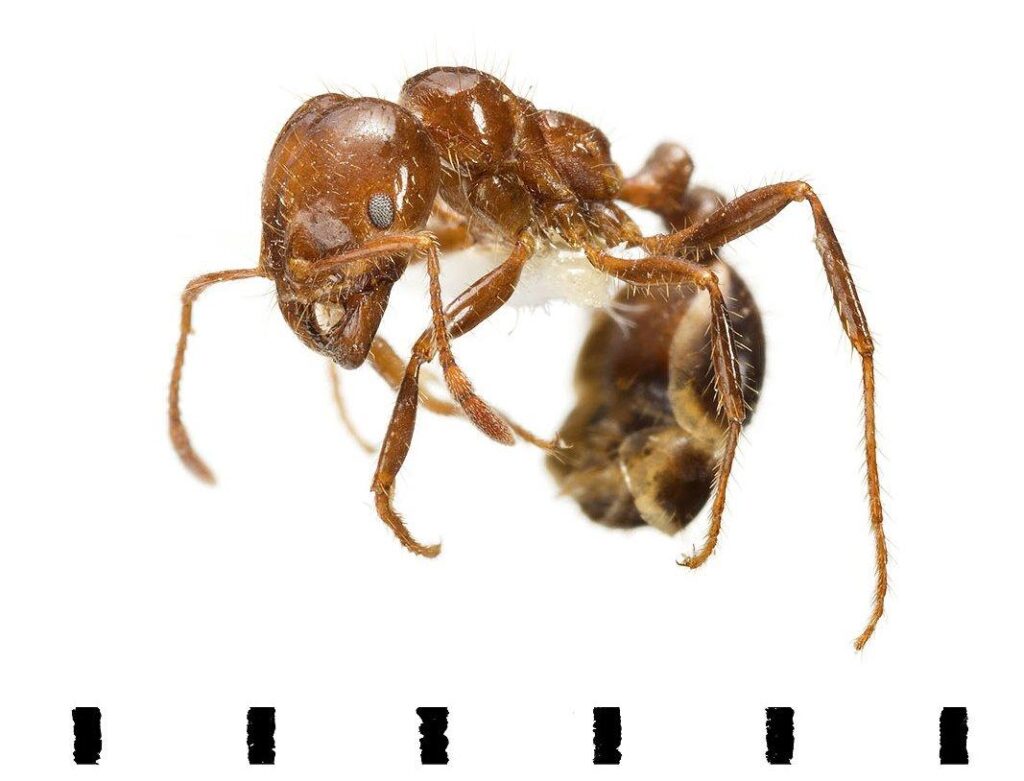
The species exerts feeding and competitive pressure on arthropods, reptiles, amphibians, birds and mammals. They reduce and displace other ants and can also have a negative impact on plant life by altering soil properties.
Solenopsis invicta Buren, 1972 by The Trustees of the Natural History Museum, London is licensed under CC BY 4.0
